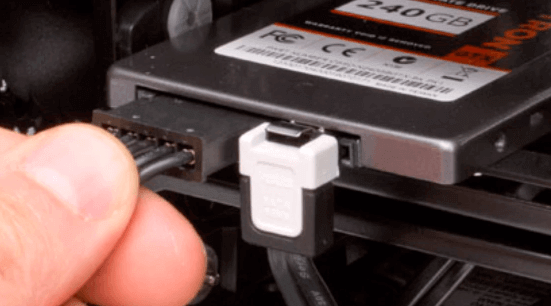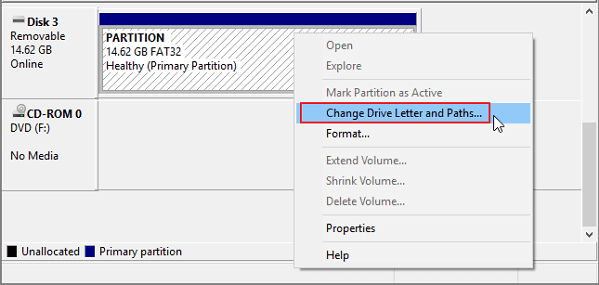Fix Hard Drive Disappeared in Windows 10 Without Losing Data
User Issue: Hard Drive Disappeared After Windows 10 Update
"Does anyone know how to make the disappeared hard drive to show up again in Windows 10? My computer received the latest Windows 10 update last night, and it automatically installed the update. The problem is that I could not see the second hard drive in File Explorer after the computer restarted. I rebooted the computer but the hard drive still disappeared. Is there a way that can help me to make the disappeared hard drive show up in Windows 10?"
When the hard drive disappeared on Windows computer, you'll not be able to visit and access the saved data. And this will result in data loss, storage space shrinking issue and other more problems. So what can you do when the hard drive disappeared on your PC? If you are facing such a problem, relax! Effective methods are available here to help now.
If it's SSD not showing up in Windows 10, go to the other page to find solutions. In addition, some of the linked page's solutions are also applicable to the HDD disappeared issue, like rescan, initialize, and check hard disk errors.
| Workable Solutions | Step-by-step Troubleshooting |
|---|---|
| Case 1. Hard drive disappeared in Explorer |
Method 1. Run hardware device troubleshooter...Full steps Method 2. Perform partition recovery in 2 Ways...Full steps |
| Case 2. Hard drive disappeared in Disk Management |
Method 1. Update device driver...Full steps Method 2. Change the drive letter...Full steps |
Quick Fix Hard Drive Disappeared Issue in Windows 10
When hard drive failed to show up on Windows PC, you can try to connect your hard drive with a different USB port to see if it helps or not. If not, you can also try to connect the hard drive to another computer to check if the issue replicates or not.
If the problem gets solved, you may need to change a new USB cable line or hard drive cable.

If the problem still exists, don't worry. Just follow the next offered methods to fix hard drive disappeared in Windows 10 error now.
Fix Hard Drive Disappeared in File Explorer Error
When you open File Explorer, and you cannot view the hard drive partition there, like D drive, E drive, and other data partitions, you can try the next two methods for help.
Method 1. Run Hardware and Device Troubleshooter to Fix Hard Drive Disappeared Issue
Step 1. Press the "Windows + R" keys.
Step 2. Type "control" and press enter to open the control panel.
Step 3. Type "troubleshooting" in the control panel search box and open it.
Step 4. Click "View all" on the left pane.
Step 5. Run the hardware and devices troubleshooter and follow the on-screen instructions.
Method 2. Perform Partition Recovery with Data Recovery Software
Windows update deletes a hard drive partition, or you accidentally perform 'Delete Volume...' in Disk Management, the hard drive will be in 'unallocated space' state. In these circumstances, Windows 10 will not recognize a hard drive partition showing up as unallocated. You can create a new partition on the unallocated drive to make it show up again. Creating a new hard drive would help Windows system detects the drive as new, but the hard drive data is gone forever.
You have two ways to recover lost partition: One is using Qiling data recovery software to restore data on the lost partition, the other is using Qiling Partition Recovery to restore the entire hard drive along with data on it.
Recover Data from Lost Partition
If you choose to create a new partition on unallocated space and need data recovery afterward, then choose Deep Data Recovery to recover hard drive data. This file recovery tool allows you to retrieve photos, videos, documents, emails, and other 1000+ file types from HDD, SSD, USB, SD card, etc.
Besides, if the lost files are corrupted, Qiling data recovery will repair corrupted files automatically after data recovery. But note that, being different from Partition Recovery software, using Data Recovery Wizard won't help recover a disappeared partition but only data on it.
Step 1. Select file types and click "Next" to start.
Launch Deep Data Recovery on your PC. Select file types and click "Next" to start.

Step 2. Select and scan the lost partition
Select "Lost Partition" and click "Scan" to search for all the lost data. If there are many lost partitions, you can identify them through its partition size.
Note: Since the Windows system doesn't support the Linux file system, the Ext2 or Ext3 partition will be recognized as lost partition with no drive letter in the software. If you want to recover data from Ext2/Ext3 partition, you can follow these steps.

Step 3. Filter the scanned results
Because there will be a lot of scanned files, you can choose a file category for quick filtering, such as Pictures, Videos, Documents, Audio, and Others. Or if you remember the file name, you can just look it up in the search box in the upper right corner.

Step 4. Preview and recover data from the lost partition
Before recovery, you can preview the file to make sure it is the data you need. Choose all the files you need and click "Recover" to restore them.
Restore Deleted or Lost Partition
Go to the product page and download Qiling Partition Recovery, and follow the guide to show up a disappeared hard drive as well as data in Windows 10.
Step 1. Select file types and click "Next" to start.
Launch Deep Data Recovery on your PC. Select file types and click "Next" to start.

Step 2. Run Qiling Partition Recovery on your PC.
Select the disk or device where you lost partition(s), click "Scan" to continue.

Step 3. Wait for the scanning process to complete.

Step 4. Preview and restore the lost partition(s).
Double-click on the partition which is marked as "Lost" with "Good" recoverability.
Let the program scan the selected disk and find the lost partition(s).
Preview the content of the lost partition. Click "OK" and click "Proceed" to start restoring the lost partition.
Step 5. Click "Recover" to finish the partition recovery process.
Note: If the program warns you that there is a conflict, back up the listed partition with essential data to an external hard drive first. Then execute the final operation to restore your lost partition.
Fix Hard Drive Disappeared/Not Showing up in Disk Management
If the hard drive disappeared or failed to show up in Disk Management, the next two steps can easily help you out.
Method 1. Update Device Drivers in Windows 10
Step 1. Right-click on the Start button and select "Device Manager".
Step 2. Expand one of the categories to find the name of your device, then right-click it, and select "Update Driver".

Step 3. Select "Search automatically for updated driver software".
If Windows doesn't find a new driver, you can try looking for one on the device manufacturer's website and follow their instructions. Otherwise, you can try to reinstall the driver by doing like this:
Step 1. Open Device Manager, right-click the name of the device and this time select "Uninstall device".
Step 2. Restart your PC and Windows will attempt to reinstall the driver.
Method 2. Change Drive Letter of Disappeared Hard Drive
Step 1. Press the "Windows + R" keys to bring up the Run dialog.
Step 2. Type "diskmgmt.msc" and press Enter to open disk management.
Step 3. The disappeared hard drive can be detected now, right-click on it and select "change drive letter and paths".

Step 4. Click "change" and assign a different drive letter.
Step 5. Save the changes, restart the computer and check again.
Related Articles
- SSD vs HDD Lifespan, Which Lasts Longer SSD or HDD? What's the Difference
- 4 WD My Passport Repair Tools: Fix Cannot Access My Passport External Hard Drive
- Recover Deleted Recordings/Shows on DirecTV
- 1TB HDD vs 256GB SSD, Which Is Better